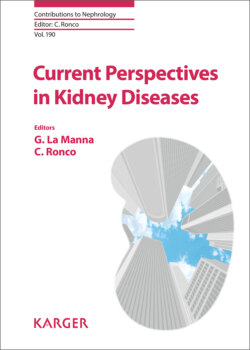Читать книгу Current Perspectives in Kidney Diseases - Группа авторов - Страница 7
На сайте Литреса книга снята с продажи.
Foreword Present and Future of Acute and Chronic Kidney Disease
ОглавлениеRecent advancements in technology and new discoveries represent a real renaissance in the field of Nephrology. After reaching a milestone in diagnostic techniques and renal replacement therapy, we are now moving towards a new generation of biomarkers for AKI, finding new possibilities of tracking damage progression in chronic nephropathies, testing new dialysis membranes and discovering new approaches for kidney transplantation. In spite of limited financial resources, several innovative opportunities are emerging in many areas of this scientific discipline, with the potential of shedding light on paths that have been either stagnant or unchanged for many years.
In chronic hemodialysis, new information about blood purification techniques and mechanisms of solute removal are now available. Adsorption and specific binding of molecules onto synthetic sorbent particles, the use of high cut-off membranes with novel electrochemical characteristics and expanded spectrum of removal characteristics have improved the ability to clear toxins in the middle-to-high molecular weight, resulting in improvements of clinical outcome.
The innovative approach to fluid management represents a further development of chronic extracorporeal treatment, strengthening the possibilities for home dialysis, with significant improvements in terms of quality of life and rehabilitation of kidney patients.
In acute renal replacement therapies, citrate anticoagulation, high cut-off membrane filters, specifically designed modules, combined techniques, coupled filtration and adsorption seem to permit synergistic interventions in the critical care setting, where extracorporeal therapies represent a method of organ support beyond kidney replacement.
Glomerulopathy therapies are in a phase of evolution. Recent evidences and ongoing trials reveal novel possibilities for treatment, thus enlarging the armamentarium of medications available for nephrologists, with satisfying effectiveness also in the long-term follow-up.
The role and validation of kidney injury biomarkers are important to establish reliable, reproducible, cost-effective, non-invasive early diagnosis. Moreover, the contribution of genetics, besides its diagnostic role, represents an essential predictive tool for risk stratification, disease progression and outcomes, providing the prospect of patient-tailored treatments based on genotype.
In addition, there is a growing body of research on mineral metabolism alterations, commonly identified as a trigger of cardiovascular disease in chronic kidney disease patients, with the involvement of FGF 23 and Klotho, especially in the earlier stages of the disease. The role of these molecules in the regulation of phosphorus metabolism represents only the tip of an iceberg: the impairment of a complex system underlying the progression of renal disease and cardiovascular damage, in a triangle involving heart, kidney and bone, with the latter representing an endocrine organ.
Nowadays, other areas, including the arteriovenous fistula itself, appear not to be vascular anastomosis, but rather an “in vivo” model of vascular damage, with the participation of several mediators and stem cells able to delineate the likelihood of restenosis and the risk of failure. Novel imaging techniques offer possibilities for making a clear diagnosis and for proposing effective remedies.
Finally, in view of the immunological complexity of kidney transplant, one of the biggest challenges is the possibility of influencing the outcomes and long-term allograft survival. The latest therapeutic options offer the possibility of implementing effective preventive measures against graft loss. New tools for preventing chronic allograft injury, the leading cause of transplant failure, are currently being developed: among them, gene expression analysis can help in identifying patients at higher risk, who might benefit from early prophylactic plans, mainly aimed at aggressive treatment of modifiable risk factors, through the control of hypertension, hyperglycemia and hyperlipidemia, CNI minimization, protocol biopsies, addressing drug adherence and performing post-transplant BKV surveillance and DSA (donor-specific antibodies) monitoring.
In a nutshell, the contributions and insights in this volume are meant for the main topics of the current research in Nephrology, and to better understand the most promising opportunities for growth and development in all sectors, ensuring a rationale for optimizing future efforts and promoting solid research.
We hope the content of the book will represent a good opportunity for students and professionals to become acquainted with new areas of research in Nephrology and to better understand why this is an era of renaissance of this discipline.
Gaetano La Manna, Bologna
Claudio Ronco, Vicenza
